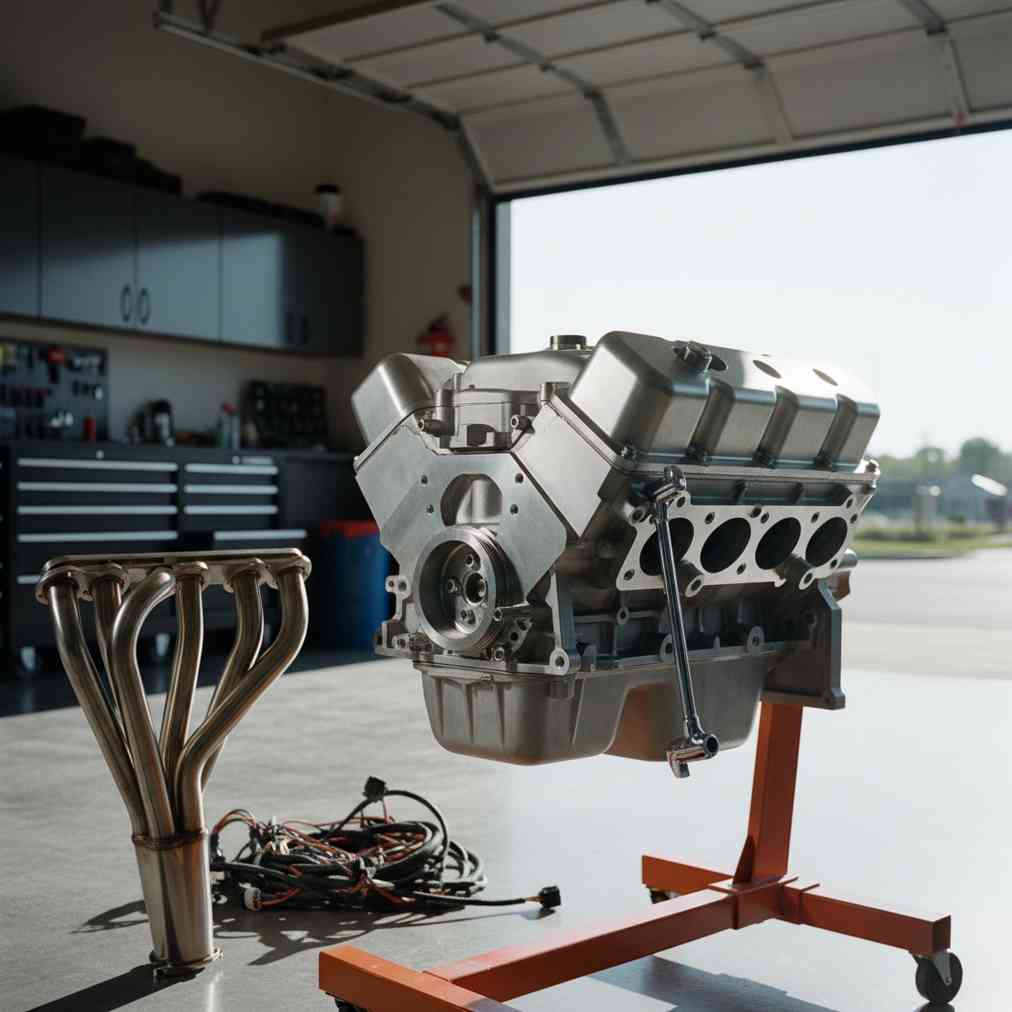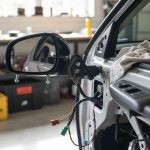Why the “Junkyard 5.3” LS Engine is the Holy Grail of Engine Swaps
The General Motors LS engine family, particularly the **5.3L V8**, has completely revolutionized the engine swap scene and become the go-to choice for project car builders worldwide. These engines represent an unmatched combination of affordability, abundant supply, modern reliability, and significant power potential in a remarkably compact package that has earned them legendary status among automotive enthusiasts.
Whether you’re building a classic muscle car, upgrading a truck, or creating a unique project vehicle, the junkyard 5.3L LS engine offers modern electronic fuel injection (EFI) technology with the raw power of a traditional V8, all while being incredibly accessible to the average builder.
The Unbeatable Advantages of the 5.3L LS Platform
The popularity of the 5.3L LS stems from several key factors that make it stand out from other engine options available in salvage yards across the country:
Exceptional Power-per-Dollar Ratio
These engines can often be sourced from salvage yards near you for less than the cost of a rebuild kit for an older small-block engine. A stock 5.3L can produce around **320 horsepower** and **340 lb-ft of torque** straight from the factory, providing an excellent foundation for any project. When you consider the cost versus performance ratio, few engines can match what the junkyard 5.3 offers.
Unprecedented Accessibility and Supply
Millions of GM trucks, SUVs, and vans have been equipped with these engines from the late 1990s through the 2010s, creating an unprecedented supply in auto salvage yards nationwide. This abundance means you’re likely to find multiple options when shopping for your swap, giving you the luxury of being selective about condition and price.
Advanced Modern Design
The LS platform features an overhead valve (OHV) design with cylinder heads that flow significantly better than many alternatives straight from the factory. This modern engineering approach offers excellent power potential with minimal modification, making it perfect for both budget builds and high-performance applications.
Compact Size and Lightweight Construction
An LS engine is known for being physically small—comparable in size to many V6 engines—and lighter than comparable big-blocks. An aluminum LS can be nearly **100 pounds lighter** than a comparable big-block Chevy, making it ideal for improving weight distribution and handling characteristics in your project vehicle.
Massive Aftermarket Support
The LS platform enjoys tremendous aftermarket support, with swap kits available for virtually any vehicle application. Simple upgrades like a camshaft swap can reportedly yield an additional **100 horsepower**, while more extensive modifications can push these engines well beyond their stock capabilities.
Essential Engine Codes and Donor Vehicle Guide
The 5.3L LS engines are generally found in Chevy/GMC trucks and SUVs from **1999 to around 2013**. It’s crucial to identify the specific engine code, as it dictates internal parts like rods and pistons, which significantly affect high-horsepower potential and reliability.
| Engine Code | Block Material | Generation | Typical Donor Vehicles | Key Notes |
|---|---|---|---|---|
| LM7 | Iron | Gen III (1999–2007) | Silverado 1500, Sierra 1500, Suburban, Tahoe, Avalanche (VIN 8th digit ‘T’) | Most popular and plentiful option. Iron block favored for high-boost/high-horsepower builds |
| LM4 | Aluminum | Gen III (2003–2005) | Similar trucks/SUVs (VIN 8th digit ‘P’) | Aluminum-block version of LM7. Lighter weight benefit |
| LH6 | Aluminum | Gen IV (2005–2009) | TrailBlazer, Envoy Denali, later trucks (VIN 8th digit ‘M’) | Features Variable Valve Timing (VVT), requires AFM delete kit |
| LC9 | Aluminum, Flex-Fuel | Gen IV (2007–2014) | Newer Silverados, Avalanches, Suburbans (often 4WD models) | Factory rated up to 320 hp. Also features VVT |
What to Avoid: The LS4 Exception
**LS4 (2004-2009):** Used in front-wheel-drive cars like the Monte Carlo SS. It has a shorter crankshaft, which causes issues with flexplate spacing and belt-driven accessories during a rear-wheel-drive swap. This engine is best avoided unless you’re specifically building a FWD application.
Identifying Gen III vs. Gen IV Internals
For budget builds, Gen III motors are often preferred as they lack Active Fuel Management (AFM) systems that complicate cam swaps on Gen IV motors. Some experienced builders specifically look for Gen III engines with Gen IV-style internals (floating pistons/thicker rods) indicated by **13mm header bolts** and **13mm lifter valley bolts**.
Essential Tools for Your Junkyard Engine Pull
When pulling an engine from a salvage yard, preparation is key. You’ll be working in tight spaces with stubborn bolts, and most yards restrict the use of torches or jacks, making hand tools absolutely essential for success.
Must-Have Tool Kit
- Socket Set: Complete metric set with various extensions is critical for reaching hard-to-access bolts
- Breaker Bar: Necessary for stubborn, thread-locked bolts that won’t budge with standard ratchets
- Wrenches: Ratcheting wrenches and shorty wrenches are highly useful in confined spaces
- Cutting Tool: A Sawzall (reciprocating saw) is often the last resort for cutting unnecessary brackets or mounts
- Penetrating Oil: Such as Liquid Wrench, for rusted fasteners that have been exposed to the elements
- Other Essentials: Pliers, wire cutters for non-essential harness/sensor wires, and impact driver (if permitted)
Key Disconnection Points During the Pull
When removing the engine and transmission assembly, focus on disconnecting these critical points systematically:
- Driveshaft and carrier bearing (if applicable)
- Exhaust Manifolds (often 10mm bolts, but can be seized)
- Electrical Harnesses and Sensors: Unplug as much as possible; cutting plastic clips holding harness to body is often easier
- Bell Housing Bolts: Some only accessible from top after removing intake manifold
- Starter bolts and electrical connections
- Accessory Brackets: Power steering pump bracket (often 15mm bolts)
- Motor Mounts (usually three bolts per side)
- Steering Shaft (disconnect to allow better access to bell housing)
Critical Parts to Grab With Your Engine
To ensure a successful swap, grab as many factory parts as possible from the donor vehicle. These parts often interchange easily and will save you significant time and money during the installation process.
Electronic Control Systems
- PCM (Powertrain Control Module) and Wiring Harness: Essential for running the engine in stock configuration. Many swappers have the PCM “de-pinned” or reprogrammed by a specialist
- All Engine Sensors: Including MAF, MAP, throttle position, and oxygen sensors
Intake and Fuel System
- Intake Manifold and Throttle Body: Necessary for engine operation. Note conversion requirements between drive-by-wire and cable-operated systems
- Fuel Rail and Injectors: Often expensive when purchased separately
Accessory Drive System
- Complete Front-End Accessory Drive: Alternator, power steering pump, A/C compressor
- Note: Truck accessories sit about 1.5 inches further out than shortest options like Corvette accessories
Transmission and Drivetrain
- Original Transmission: Keeping original transmission (like 4L60E) and torque converter makes initial setup much easier
- Flexplate/Flywheel: Matches engine’s specific requirements
Cooling System Parts
- Radiator Hoses and Shroud: Stock parts can often be modified for new application
- Water Pump and Thermostat Housing: Essential for cooling system operation
Miscellaneous but Important
- All Fittings, Connectors, and Clamps: As one experienced builder advises, “When in doubt, keep it!”
- Engine Covers and Heat Shields: Often overlooked but important for proper operation
- Dipstick and Tube: Specific to engine application
Pro Tips for a Successful Junkyard Pull
Before You Go
- Call Ahead: Verify the yard has the specific vehicle/engine you need
- Check Weather: Avoid rainy days when possible – wet conditions make everything more difficult
- Bring Help: Engine pulls are much easier with at least one helper
- Plan Your Route: Know exactly where you’re going and have backup yards identified
At the Yard
- Inspect First: Check engine condition before starting removal process
- Take Photos: Document connections and routing before disconnecting
- Work Systematically: Don’t rush – methodical approach prevents mistakes
- Label Everything: Use masking tape and markers to label harnesses and hoses
“The key to a successful junkyard engine pull is preparation and patience. Take your time, bring the right tools, and don’t be afraid to ask yard employees for advice – they’ve seen it all before.”
Understanding Engine Condition and Value
Not all junkyard engines are created equal. Learning to assess engine condition quickly can save you time and money while ensuring you get the best possible foundation for your swap project.
Visual Inspection Checklist
- Oil Condition: Check dipstick for metal particles or coolant contamination
- Coolant System: Look for signs of overheating or mixing with oil
- External Damage: Inspect for cracks, missing parts, or impact damage
- Wiring Condition: Ensure harnesses aren’t cut or damaged
- Accessory Condition: Check that alternator, power steering pump, and A/C compressor are present
Red Flags to Avoid
- Milky Oil: Indicates coolant contamination, possibly from blown head gasket
- Metal Shavings: Sign of internal engine damage
- Missing Major Parts: Intake manifold, heads, or other critical parts removed
- Fire Damage: Avoid engines from fire-damaged vehicles
- Flood Damage: Water damage can cause extensive internal corrosion
Planning Your LS Swap Project
Successfully integrating a junkyard 5.3 LS engine into your project vehicle requires careful planning beyond just the engine itself. Consider these factors to ensure your swap goes smoothly.
Compatibility Considerations
- Engine Mounts: LS engines require specific mount solutions for your chassis
- Transmission Compatibility: Ensure your chosen transmission works with LS bolt pattern
- Cooling System: Plan for adequate cooling capacity and radiator placement
- Fuel System: LS engines require higher pressure fuel systems than older engines
- Exhaust Routing: Consider header clearance and exhaust system modifications
Budget Planning
While the junkyard 5.3 represents excellent value, don’t forget to budget for supporting modifications and parts that will be necessary for a complete swap.
| Item Category | Estimated Cost Range | Notes |
|---|---|---|
| Engine | $500 – $1,500 | Varies by condition and location |
| Engine Mounts | $200 – $500 | Application-specific |
| Wiring/PCM | $300 – $800 | Professional tuning recommended |
| Cooling System | $300 – $600 | Includes radiator, hoses, fans |
| Exhaust System | $400 – $1,000 | Headers to complete system |
| Miscellaneous | $500 – $1,000 | Fluids, gaskets, hardware |
Legal and Safety Considerations
Before diving into your LS swap project, it’s important to understand the legal and safety implications of engine swaps in your area.
Emissions Compliance
- Research Local Laws: Emissions regulations vary significantly by state and locality
- OBD-II Compliance: Most areas require functional OBD-II systems for emissions testing
- Catalytic Converters: Must maintain or improve emissions equipment from donor vehicle
- Documentation: Keep records of all parts and modifications for inspection purposes
Safety Considerations
- Professional Installation: Consider professional help for critical systems like fuel, brakes, and steering
- Insurance Implications: Notify insurance company of engine swap
- Registration Requirements: Some states require inspection or re-registration after engine swaps
Maximizing Your Investment
When you’re ready to sell your current vehicle to fund your LS swap project, getting top dollar can significantly impact your build budget. The money saved on the front end gives you more resources for quality supporting modifications.
Performance Upgrades on a Budget
One of the beautiful aspects of the LS platform is how much performance you can extract with relatively simple modifications:
- Camshaft Upgrade: Single most effective modification, can add 80-100 horsepower
- Cold Air Intake: Improves airflow and engine sound
- Exhaust System: Long-tube headers provide significant power gains
- Tune: Professional tuning optimizes all modifications
Common Pitfalls to Avoid
Learning from others’ mistakes can save you significant time, money, and frustration during your junkyard 5.3 LS swap project.
Planning Mistakes
- Insufficient Research: Not understanding your specific engine variant’s requirements
- Underestimating Costs: Focusing only on engine cost without considering supporting modifications
- Ignoring Compatibility: Assuming all LS engines are identical in mounting and accessories
- Poor Tool Preparation: Arriving at the yard without proper tools for removal
Technical Oversights
- Wiring Issues: Underestimating the complexity of integrating LS engine management
- Cooling Problems: Inadequate cooling system planning leading to overheating
- Fuel System: Not upgrading fuel system to handle LS pressure requirements
- Clearance Issues: Not checking for interference with steering, suspension, or body parts
The Future of LS Swaps
As the automotive industry continues evolving toward electrification, the window for affordable LS swaps remains wide open. The massive installed base of these engines ensures continued availability for years to come, while advancing technology makes integration easier than ever.
The junkyard 5.3 LS represents one of the best value propositions in automotive performance history. With careful selection, proper preparation, and methodical execution, you can transform virtually any project vehicle with modern V8 power that’s both reliable and potent. Whether you’re building a weekend warrior or a daily driver, the LS platform offers the perfect foundation for your automotive dreams.
Remember to take your time during the selection and removal process. The few extra hours spent choosing the right engine and gathering all necessary parts will pay dividends throughout your build process. With the right approach, your junkyard 5.3 LS engine will provide years of reliable service and endless smile-inducing performance.





Leave a Reply
You must be logged in to post a comment.